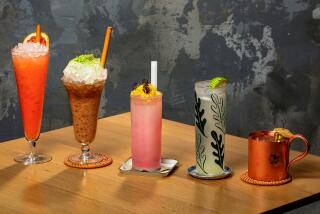Perfect Martini Is All in the Way You Spin the Yarn
Few things--with the possible exception of mothers and Philadelphia--have been so mythicized and misunderstood, politicized and polemicized as the humble martini.
Now this perfumed bushwhacker is back, enjoying a fresh legitimacy alongside cigars and noisy motorcycles as we, by the several millions, exert our individuality.
Or maybe we’re subconsciously protesting wagged fingers and incessant warnings that we shalt not smoke, drink our drugs, eat red meat, flirt in the workplace, stand until the captain turns off the seat belt sign, kiss dogs on the lips or entrust our precious skulls to Harley-Davidson.
As part of this ginny revival, a new generation has resumed old odysseys to identify the fount and formula for the perfect martini. Gin or vodka? Shaken or stirred? Glasses in the freezer first? Gargle with vermouth and spit into the gin?
Now, trust me on this.
It’s all myth and twaddle.
And that’s a declaration sound as a pound, baby, and rooted in visits to all the tall temples of St. Martinez.
* Harry’s Bar and Grill in Venice: The glass we received was for wine, and the gin we were poured came from a bottle without a label. As Harry’s was Hemingway’s favorite tavern, we must presume an anomaly. Or that despite all the propaganda, Papa really didn’t know cocktails from cough medicine and was just another victim of martini mania.
* The Savoy in London: They leave pits in the olives. Try telling your dentist you cracked a crown on a martini.
* The Plaza in New York: Generic gin if you don’t specify, and a sour onion the size of a shallot.
But here’s the odd thing. Gin is gin is gin, and quite tolerable, even pleasurable, if the traveler’s spirits are down. But when stripped of heritage, frills and a loving pedantry, a martini is just another amorphous highball, and one not really different from another.
In short, pouring the perfect martini has nothing to do with the mix. Like memorable sex, it has everything to do with romantic ritual, foreplay and a little embellishment, even a splash of secrecy to keep fascinations alive.
*
Herb Shannon--writer, frustrated Liam O’Flaherty, ancient mariner, world traveler and once Gen. George Patton’s combat photographer--shares this realization and assisted my great escape from the myth.
Herb, now resting on his olives in San Pedro, claims the world’s best martini is made from nine parts British gin, one part Italian vermouth. With gin poured on the ice cubes. In a traditional, stemmed, triangular martini glass. With an onion and an olive sharing a single pick.
But I couldn’t help noticing his appetite for the end of the drink. He’d chomp into the onion, chew the olive at the same time and, aaaaah, close his eyes at this odd marriage of flavors.
“A moment of truth?” I suggested. “If there weren’t a gin-soaked onion and olive for a finale, would you bother drinking martinis?”
He snorted in his second gin: “Of course not. Anticipating the onion and the olive makes the gin bearable. Otherwise, a martini is the world’s most boring, even brutal drink.
“And I remember exploring this theory with Gen. Patton after we’d landed in Sicily in ‘43, and he said: ‘Son, the military careers of Custer, Montgomery and Napoleon went a long way on bluff and bull. So has mine. Why should building a martini be any different?’ ”
Herb probably made up the bit about Patton.
Yet that’s the soul of the world’s best martini: heavy on the trappings, a splash of anecdotes, and blended with a full measure of bonhomie. Here is the best and I choose to share my masterpiece with you, my companion in the sublime. And if you are not entertained by the process, how about a diet Shirley Temple?
*
My start was a natural.
Rory Calhoun--dear friend, fellow keeper of the mystique, and cowboy by career and mind-set--gave me a god-awful martini shaker, all golden flamingos and flying pheasants, a definite collectible from the ‘40s. It was so ugly, it was beautiful.
“Tell ‘em it used to belong to W.C. Fields,” growled Calhoun. “Tell ‘em this mixed the one that killed him. Tell ‘em what they want to believe, what seems to make sense, but what also is as obscure as hell.”
I decided the gin. Bombay Sapphire is too faddish, Tanqueray too popular. Make it Boodles, definitely an arcane booze. Say the name pays homage to Boodles, a gentleman’s club founded in London in 1762 for fine eaters, card players and gentlemen.
Should anybody decide to check, that’s the absolute truth.
Glasses should be conversation pieces. A lot of flexibility here. Traditional cheapos cost 50 cents at better thrift shops and are ideal--because they represent the birth of this creation and will lead to your intriguing tale of finding four original martini glasses, mint, unused, still in their Libby box at a Goodwill store in Eureka.
Or you can spend $50 apiece on Waterford glasses--allowing you to mumble something about not defiling superb gin in ordinary glasses. Then mention that Waterford makes martini glasses only in a Lismore (in Gaelic, Lios Mor) pattern to commemorate the 10th Duke of Devonshire who introduced the martini to Waterford County and Eire.
And there’s a lot of truth to that story.
Picks are another essential. I have an Art Deco set in silver--from Beaver’s Den in Tarzana--and four ivory picks from the dry-rot destruction of my father’s old cocktail cabinet.
They give guests options. Silver or ivory? It’s probably an old wives’ tale, tell them, but Wallace Simpson always believed silver added an extra sparkle to the gin. Gold seems to turn it green.
Olives must be anchovy-stuffed. Because if not plopped into martinis, what earthly use is there for anchovy-stuffed olives? Onions must be sweet, Silver Skin by Cross & Blackwell. Because, you say, that’s what Herb Shannon, writer, frustrated Liam O’Flaherty, ancient mariner and world traveler, put in Gen. George Patton’s martini.
It was Old Blood and Guts, incidentally, who insisted on a 9-1 mix with Beefeater gin and Martini & Rossi vermouth, poured on the ice cubes. Then, because he commanded the Seventh Army, Patton would shake the mix exactly seven times before pouring. Or so claimed Eisenhower.
*
So therein all the ingredients, mixology, accouterments, script and stage directions for creating the world’s best martini. Inarguably, and without fear of challenge. For you have donated a large portion of your life to researching the verity. Besides, all witnesses to the contrary are dead.
Yet may your penalty for elaboration, for converting a simple martini into performance art, be less than mine. A month ago, while I was washing W.C. Fields’ shaker, it slipped and smashed in the sink.
Fortunately, my daughter, who has shared in all this fun, has found a replacement prop.
It is from the ‘30s, very traditional, silver-plated, and from Alfred Dunhill of London. I am having it engraved with initials: NPC.
You probably didn’t know that Noel Coward bought all his silver stuff from Dunhill.
More to Read
Eat your way across L.A.
Get our weekly Tasting Notes newsletter for reviews, news and more.
You may occasionally receive promotional content from the Los Angeles Times.









